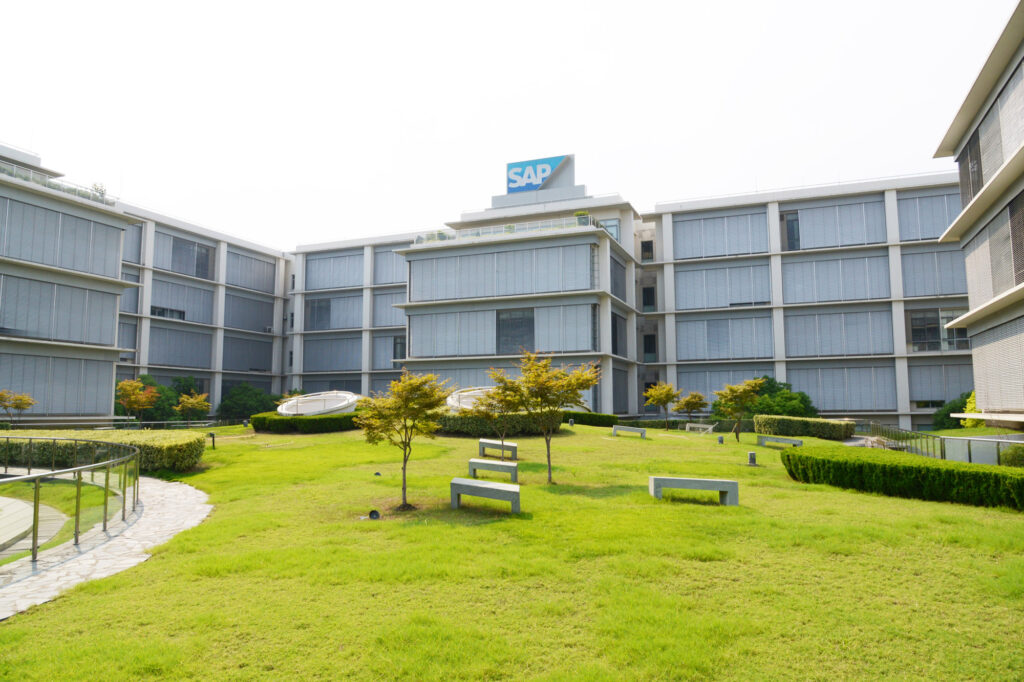Disruption is the new norm, especially for supply chains that have to function with greater efficiencies, for a more demanding customer base, while adhering to sustainability regulations. The result is the biggest technology acceleration ever seen hitting the industry, through the explosion of generative AI. John McNiff talks about SAP’s influence on companies, enabling smoother data flows across supply chain networks with more connected and intuitive technologies, for ultimate risk resiliency, agility, and in support of the green agenda. Here, he explains this complex landscape, and how far we are away from an autonomous, self-healing supply chain.
Hi John. You have been with SAP for more than 15 years now in various roles, leading to your current position as part of the global Centre of Excellence. Firstly and briefly, what does this entail?
Basically, we run a team focused on strategic go-to-market topics. For example, right now we are working with customers to ensure we can articulate the business value of a supply chain that doesn’t run in silos. In general, for us, the digital supply chain covers quite a broad gamut. Everything from PLM, product innovation, supply chain planning, logistics, manufacturing, the shop floor, but also operations and service.
We have a lot in the portfolio and already, with the speed of innovation and rise of generative AI, there is a lot to look forward to and get stuck into.
From this multi-focus perspective then, you seem perfectly placed to pinpoint where supply chain challenges and disruptions are being felt at present?
Yeah, I’d say it’s good that we were talking now, because I think even in the past few months the talk track is changing.
First, we’ve had ‘VUCA’ (volatility, uncertainty, complexity, ambiguity) that people want to talk about, highlighted of course by the pandemic, Suez Canal, etc, etc. But that view is now evolving to be on a sort of rolling stream of disruption rather than battling one particular ‘black swan’ event at a time.
To that end, the focus among companies is to be less reactive, and putting strategies in place to be more risk resilient and agile.
View this content as a digital brochure – click below:
When there are so many potential disruptions, how does SAP plan and prepare to ensure you’re enabling companies with that risk resilience and agility?
It’s actually a case of looking at what the next potential gamechangers will be, and there are four main areas on our horizon. Yes, number one is that we are in the business of helping with risk aversion and business agility, but we can provide this by accounting for future – or escalating – challenges we see coming up; of which there are three more specific examples.
First, issues around sustainability are growing and people aren’t ready for that yet from a technology perspective. They need to start thinking about how they embed traceability and provenance around CO2 and ESG into the supply chain, when a lot of this data and information is outside of companies’ own four walls. For example, with CO2, 90% of the CO2 footprint of most big manufacturing companies typically sits in operations and the supply chain, and more that 60% on average is in scope 3 (beyond the internal enterprise). Regulations around the world are now calling for reporting of this carbon footprint in a much clearer and transparent way, so there’s a need to connect this data from across manufacturing, operations, and the wider supply chain ecosystem to give accurate measures and not just averages.
The next area of focus is helping companies not to just report, but also using this connected thread of data to make decisions around how operations and the supply chain are run. You work backwards along the digital thread to see where shortfalls or inefficiencies exist, and to then take steps to become more resilient or efficient. This not only effects regulation compliance, but also helps to adhere to a younger customer contingent who prize sustainability higher than before, while also making yourself more attractive to investors. So, we also need to make that link between having better connected information, and then acting upon it.
And then, there is the technology itself. There has been an explosion in generative AI in particular, which has refocused everyone’s mindsets, but that doesn’t mean they necessarily understand it or know how best to use it. Helping with this understanding and to take full advantage of AI’s potential is another remit for us, alongside these aspects of sustainability, and more insight and actionable data generated from connected sources.
A word that springs to mind here is ‘visibility’, enabling companies to get a better picture of what is possible, but also where their current bottlenecks exist?
It is absolutely a key word, however when you say ‘visibility’ to people, they still have an image of a control tower and just having that visibility in a first instance – tech giving a representation of the status quo. When asked whether they have complete visibility though, and whether they can make decisions from that picture including outside of their business’s four walls pertaining to the supply chain, very few can say they have that capability.
Where we focus our conversation around visibility is on the ability to act on the information being presented. The ability to connect pieces of information across functions and departments. The ability to process the information and respond in an optimal way. The ability to leverage new technologies to provide real-time, continuously updating insight so that companies can remain agile and risk resilient.

To SAP, visibility now isn’t just a picture. It’s the ability to connect external data, alerts and events with business data and transactional information, such as sales orders, production orders, transport orders, and all other elements that drift in and out of the immediate four walls of a business. Not only that, but it’s also then about understanding the impact of information you’re receiving on each strand of the operation.
John McNiff
Effectively creating the digital twin of the ‘network’ at present, despite the promise of technology, this complete notion of visibility is unachievable for many.
You mentioned the term ‘digital threads’ earlier. Presumably, it is the formulation of these digital threads that you’re talking about when you describe this improved connectivity and flow of data?
Absolutely, but again it’s a bit of a misunderstood phrase in the same breath as ‘end-to-end visibility’. In some industries or contexts, it refers to an engineering change, for instance, that could then be applied across the board seamlessly thanks to all systems updating that information.
What we mean by digital thread, however, is all the data, records, orders, communications and information that needs to be connected. But more than that backbone, it’s about having analytical capabilities and decision-making support on top of that information. Then, from a supply chain perspective, it’s also about bringing in external data from other systems and leveraging the complete ecosystem. This might implicate partners down the chain, but also systems around weather data for example, or transport complications in real time. Everything that relates to a company’s ability to deliver on a promise to customers, needs to be weaved into this thread, analysed automatically in real time, and lend to more efficient and informed decision making.
From a practical standpoint, where does SAP fit into this equation? In a perfect world, I’m sure you’d advocate a complete suite of SAP solutions for optimised synchronisation, but that won’t be feasible for all?
The first thing to do is take as much advantage as you can of the backbone and of the system of record, there is a wealth of hidden knowledge already waiting to be tapped into within the enterprise. Having consistent master data in a system of record is very powerful thing. But you’re right – transformation is big, intimidating and expensive, so there is much more of a shift to becoming as composable as possible. This means taking smaller pieces of augmentation at a time, and we help to make sure that everything is integrated and synchronised across the value chain.
Architecturally, there is also a shift from the rigid monolith setup versus best-of-breed alternative, to something in-between, which leverages best-of-breed but in a best-of-suite concept with a consistent platform. This helps from an IT perspective, where you’re sharing as much of that digital backbone master data as possible and embedding the bits you need to embed. For example, with the green agenda, you can connect material master data with emissions factors which is something that seems quite boring in the backend, but in the context of the users in the supply chain, if they can see the impacts of picking this material from this supplier, or routing it via this transportation provider, they can measure the emissions factor changing across each possibility, lending to better decision making.
So, you have this consistent backbone, while infusing applications to enhance the value of that master data. From our perspective, it’s about making our platforms composable in that way… open in that way. It makes the task of transformation more feasible, less daunting and more effective.
Are you able to provide a couple of examples of how this composability is reflected in your evolving offering?
For a number of years we’ve been building products that integrate into different areas of business operations, but the important differentiation in recent times has been around this composability and synchronisation. So, making them composable but tightly coupling them with that master data, with the ability to add decision capabilities on top, underpinned by a common user interface as part of a bigger suite.
What’s getting really exciting is the move towards intelligent technologies, though, which a lot of people haven’t taken advantage of yet. So, moving to SAP S/4 HANA – it’s infused with analytical capabilities, with the ability to get out more data and do all this clever analysis and bring data together from different sources. Honestly, a lot of people have not really taken advantage as much as they could from that, because they’ve kind of shifted from what they had, to doing it the same way but with a different system.
Where things like AI come in now is we can start to build models that learn from the whole of the SAP ERP suite of 20,000-40,000 customer processes. Whereas at the moment, if people want to do digitisation, or add intelligence, they’re doing so on a case-by-case basis, using their own tools, and to some degree, creating a new spaghetti-soup best-of-breed landscape. What we’ve got the potential to do with the platform now, and especially with the explosion in AI capabilities, is to say, because it’s in the cloud, we can build these foundational business AI models and allow you to access them, fine tune and ground them responsibly, and apply them to your data; to become much more automated, intelligent and even generative.
This is where having all of these building blocks starts to become a real differentiating and transformative landscape. A lot are building data lakes and putting nice analytical tools on data lakes, which means they extract some information but then when they find out they’re missing some context, they have to go back and create new extracts. We have the ability to get at any data or any information, keep its context where it exists, and bring greater analytics. And especially with AI, we can start building models that learn from previous incidents and relationships.
When you have a tech shift dovetailing with external events, changing customer demand and the sustainability aspect all at once, this need for connected and intuitive insight must be paramount?
We see it play out in examples all the time. For instance, logistics might know that something is delayed or short of required volume, but manufacturing would usually only find out when they book it into the warehouse. They then create a three-week plan based on materials that either aren’t coming or that will be late. It’s not just a system, but rather a process change that’s needed, where the system needs to enable better cross-departmental collaboration.
The above example also brings in other areas that SAP is working on such as starting to use natural language and analytics to enable more seamless interactions, through foundational tools such as Joule and Just Ask. Here, you could ask what late shipments to expect, from who, and what impacts they will have on the shop floor, before making recommendations on how to resolve. These questions can only be answered if there is data feeding into each other, from logistics to warehousing to distribution and manufacturing; also incorporating the external aspects (weather, transport, etc) we discussed earlier.
It’s about mapping the complete situation to give a real time overview of what’s possible, so that smarter decisions can be made ahead of time, rather than having to react to a late shipment or delayed arrival and risking the ultimate delivery of items you’ve promised.
Where do companies start, then? It’s often the first step of a transformation that proves most daunting…
This is indeed the question, and where people are struggling. There are so many strands to it and so many exciting technologies implicating things like AI and natural language as we’ve discussed. It’s not just a transformation of tech, but of ways of working and the people impacted within that. However, on the plus side, nearly all companies are aware that they do need to transform and to align themselves with these innovations. It doesn’t necessarily mean they know what everything means though – and that’s where SAP and our partners come in, not just as tech providers but as guides of each customer’s respective roadmap.
There’s a whole world of new capability, domain expertise, process change, where we really need to work together as technology providers, implementation consultants, business process consultants, and the companies themselves. The latter link in the chain can’t be overlooked, though. I see a lot of comments from decision makers pleading that we ‘stop pushing technology for technology’s sake’ – a comment I 100% agree with. But that statement can’t be an excuse to ignore the potential of tech like AI or cloud altogether. It should be a nudge to better understand the applications at your disposal to then see the true impacts they could have on your business.
Content Sponsor and Strategic Partner: PwC
Obviously, we’re talking about your customers’ supply chains, but your own ecosystem must be so important in order to keep ahead of the curve and to keep delivering these future-proofing technologies?
When we talk about composability, about providing a platform, there is a mass of whitespace, especially around the usage and incorporation of data, and formatting things in a particular way. We have an industry cloud strategy where people can build applications that complement solutions, using the same business technology platform, using AI in different ways.
Partners like PWC have great business process experts in the context of the supply chain so bring knowledge to us around such tools and processes. Bringing that knowledge together for customers, we don’t have enough people to tell everyone how to go about it, what needs doing, the types of data needed, the AI tools to adopt, how to adjust processes. Partners like PwC and others bring both solutions and consultation that complements our business technology stack and also fills the gaps where needed. It’s about offering an ecosystem that helps people go through a transformation, understand business impacts, apply technologies and solve very specific problems.
Having those partners within that ecosystem, is hugely important.
Looking ahead as an ecosystem, but also as a global heavyweight such as SAP, what is your focus for the coming 12 months?
If you look at it strategically, I think SAP’s focus overall is to become the business AI backbone – this decision support platform for end-to-end business. In the context of the supply chain, that brings opportunities for efficiency increases, for people to become more predictive, to connect processes, and get that context across the entire supply chain.
People talk about things like the autonomous supply chain or the self-healing supply chain, and nobody is there yet, but it’s something we’re striving for and making steps towards. Over the next 12 months, we want to see those next steps of more autonomy and improved decisions off the back of connected data for our customers.
This progress will focus on areas such as sustainability where transparency, connectivity, traceability and visibility are all bottlenecks for companies, but more generally we want the next year to be one of increased adoption of solutions that will make supply chains more resilient, more agile and more accepting of ground-breaking benefits such as AI.
In doing so, our customers will be better equipped to stay ahead of that new norm where disruption is a continuous state of play, rather than a series of individual events.


